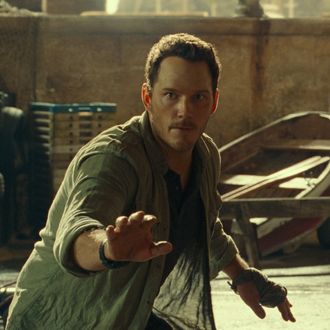
For years — seven of them, to be precise, ever since Jurassic World premiered — I have listened to people talk about how silly they think Chris Pratt’s raptor hands are. These critics regard animal trainer Owen Grady (played by Chris Pratt and his hands) extending his arms toward aggressive dinosaurs as being nonsensical and dangerous, as though they aren’t animals he has trained since birth to obey his commands. They believe Grady should’ve been eaten alive in the first film, and they have no appreciation for the “triangulation” method Grady teaches Alan Grant and Maisie Lockwood, with which all three of them use raptor hands to corral baby raptor Beta in Dominion. Well, today I say to you: These people are wrong. Raptor hands are right.
The original Jurassic Park film accomplished many things: made box office history, raised the bar for special effects, and — perhaps most enduringly — traumatized an entire generation of children who would forever live in fear of the velociraptor. The film, as well as the Michael Crichton novel on which it’s based, depicts velociraptors as cunning, vicious predators:
They killed even when they weren’t hungry. They killed for the pleasure of killing. They were swift: strong runners and astonishing jumpers. They had lethal claws on all four limbs; one swipe of a forearm would disembowel a man, spilling his guts out.
In the book they can chew through iron bars, and in the film they’re able to open doors, all while seemingly wanting nothing more than to rip every human being on the island limb from limb just for the fun of it.
When the trailer for Jurassic World was first released, those of us who had grown up with this understanding of the velociraptor lost our tiny minds when we saw the first image of Pratt seemingly controlling a pack of them with his bare hands.
We weren’t ready for it at the time — but now, seven years later, as Jurassic World Dominion brings this era of the Jurassic franchise to a close, our comprehension of raptor hands should have evolved. We’ve watched Grady and his beloved raptor Blue interact from a respectful not-closer-than-the-hand distance for three films, and we’ve even seen raptor hands fail when a distressed Blue snaps angrily at Grady in the beginning of Dominion, as if to definitively prove that this is not a Jedi mind trick but a means of silent communication. After all, this is a franchise that relies not on supernaturalism or alien technology but on the scientific possibilities that exist within the real world.
To understand how humans would actually relate to a predator like the velociraptor, we can look to how we engage with the apex predators that exist among us today. Lions, tigers, bears: Are they dangerous? Yes. Are they roaming the wilderness actively seeking out human beings to tear apart? Not unless something is terribly wrong with them. Bear attacks are uncommon, and shark attacks are similarly rare — and are sometimes the result of a shark only being able to investigate strange things by biting them. (As I understand it, if sharks had thumbs or fingers, they would simply grab you and swim off, if that image is at all comforting.)
Better yet, consider wolves, which are highly intelligent pack hunters like the velociraptor with a bite strength beyond that of any dog, so they can very easily crush a human skull. And yet between 2002 and 2020, only 489 people worldwide were attacked by wolves, and 78 percent of those attacks were a result of rabies. Only nine fatal wolf attacks were considered acts of predation (as opposed to a provoked attack). Simply put, even a pack of wolves that could easily rip you limb from limb will not hunt you down and kill you unless they’re really desperate or you seem like exceptionally easy prey. In a sense, wolves (and velociraptors) share some traits with humans: We’re pack-minded apex predators just trying to live our lives, and all of us would rather be chasing down a scrumptious and comparatively easy-to-obtain meal than fighting each other to the death.
Comparing the velociraptor with the modern apex predator is important because when we look at Pratt’s velociraptor hand move, we aren’t looking at someone trying to psychically control a prehistoric monster. In the wild, if you are confronted by a bear or a cougar, you’re supposed to use your arms to make yourself seem bigger. This would look really silly in a movie, too, but when you’re face to face with a mountain lion, you aren’t gonna care much about how you look on camera. It’s also important when facing a wild predator to hold your ground as opposed to running, which will simply trigger its instinct to chase and kill (we see this in Jurassic World in the moment, right after that infamous screengrab, when he runs for the exit and the raptors absolutely chase and try to kill him).
In the clip above, Pratt illustrates how the hand move helps him add size to himself in the eyes of a raptor. The slight squat allows him to actively hold his ground while remaining at the ready in case he needs to dive-roll out of the way, as demonstrated by Barry Sembène (Omar Sy) in Dominion. Hand gestures are in fact an important tool for many animal trainers because physical movement is something animals respond to keenly. Grady has known Blue (and the other raptors from the first movie, RIP) since infancy and earned their trust; he doesn’t run around indiscriminately throwing up raptor hands at any dinosaur he encounters. (The one time he does do that — to some atrociraptors in Dominion — it doesn’t work.) In the first Jurassic World film, the nefarious Vic Hoskins (Vincent D’Onofrio) attempts to do a raptor hand and gets that hand eaten. But Grady clearly has a relationship with these animals, enough that they recognize the legitimacy of his raptor hands.
To some anti-handsers, the very idea that a human could have a relationship with a velociraptor is risible. This idea is even mocked in Dominion, when Ian Malcolm expresses shock that Grady has “made a promise … to a dinosaur?” In some ways this just speaks to the difference between how Steven Spielberg and Colin Trevorrow interpret this work. To Spielberg (and, for that matter, Crichton), the dinosaurs function as monsters — not unlike the shark in Jaws — that are determined to do nothing but kill the humans. (Spielberg lightened up on this a bit in The Lost World, which at least justifies the T. rex’s aggression with a note about them being territorial and protective of their young.) But while both of Spielberg’s movies depict dinosaurs and humans interacting in chaotic, unplanned, 24-to-36 hour spurts, Trevorrow’s Jurassic films seek to consider the long-term dynamic between dinosaurs and humans. To do this, he has in many ways mapped onto the dinosaurs the relationship we have with other animals — and especially the various kinds of relationships we have with animals.
Ever seen a little show called Tiger King? It’s all about how there are people in this world who touch wild apex predators with their bare hands, a thing every law of nature tells us should not happen. Our DNA screams at us with the fire of 100,000 years of evolution to avoid these animals, and yet we find the idea that someone has a pet tiger or bear or wolf endlessly charming. Maybe taking an animal we’d normally fear and making it dependent on us is a way to feel safe, to convince ourselves that humans are indeed at the top of nature’s food chain and … Oh, wait, did I just stumble upon the central idea of every Jurassic movie? Wow, it’s almost as if Pratt’s raptor hands represent humanity’s futile attempts to dominate nature, not unlike the park’s electric fences and population control.
Which isn’t to say that raptor hands’ symbolic function invalidates their genuine applications within dinosaur husbandry. I want to draw your attention to Karen the emu, whom you might know if — like me — you follow a lot of farmers on TikTok. Karen is a resident of Useless Farm, and she hates her farmer, Amanda. She tries to attack Amanda every chance she gets. This is no joke, as emus are, according to the Encyclopedia Britannica, one of the six most dangerous birds in the world. They may also be descended from raptors, which as every student of Alan Grant’s knows, eventually (allegedly) evolved into birds.
How does Amanda fend off these emu attacks? With her outstretched hand:
And also, now, with this little hat:
Oftentimes when you find yourself in an argument, it’s good to ask yourself if what you’re defending is a logical position or just a part of your identity you’re afraid to lose. For 30 years, we’ve understood that if anyone were to bring velociraptors back to life, they would rampage through the streets, murdering every living thing in sight. The reality is we don’t actually know — nor do we have any way of knowing — how raptors would act. But we can safely assume the velociraptor is not just evil incarnate.
They are animals, fundamentally the same as those all around us, and they are learning about humankind the same way we’re learning about them. Is it really all that incredible to think the relationships people have cultivated with an array of contemporary apex predators could be possible with dinosaurs? Doesn’t it seem plausible that their behavior would mirror predators we already know? Someday, if you find yourself facing down an apex predator during a hike gone awry, hopefully you will follow Grady’s example: Stay calm, make your arms all big, yell “Hey!” real loud, and hold your ground. And in that moment, as you enjoy not being mauled, you will hopefully have learned to respect the raptor hands.


